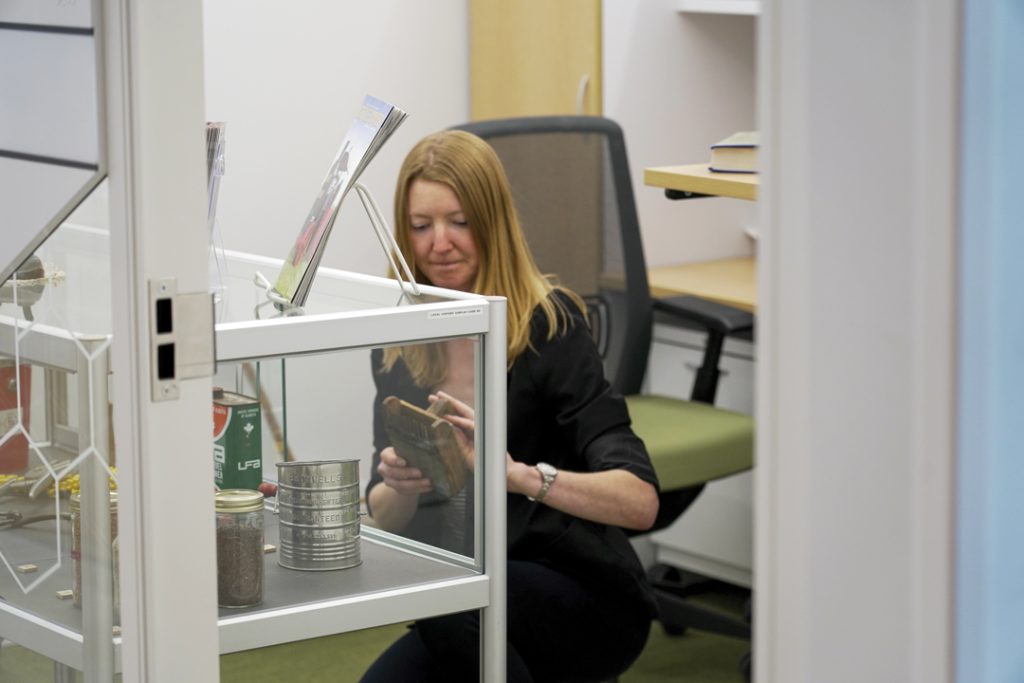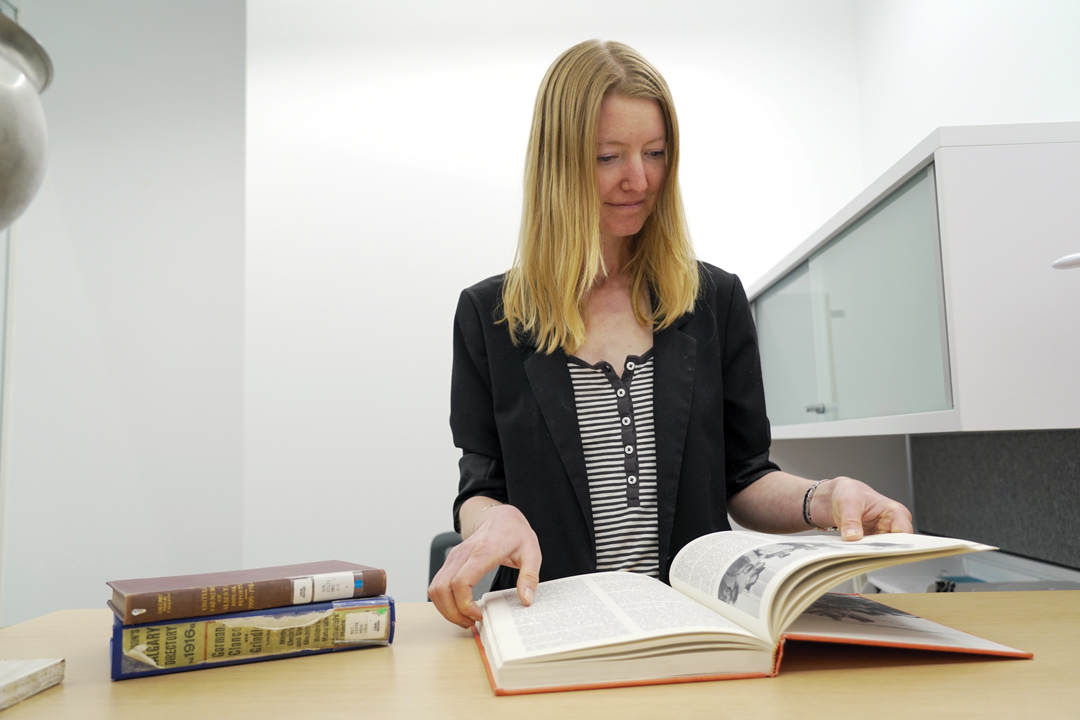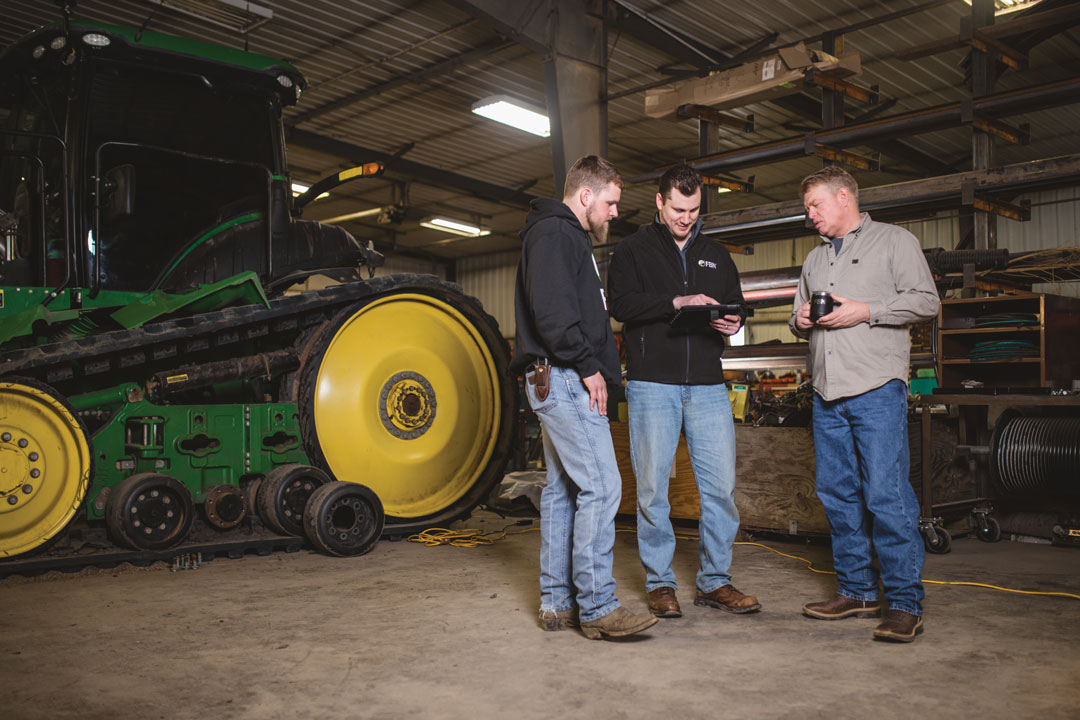KNOW YOUR PAST
BY CAROL PATTERSON • PHOTOS COURTESY CALGARY PUBLIC LIBRARY
In her words, Shelly McElroy is attracted to a good Alberta story like a magpie after a shiny object. As the curator of the Pioneer Acres Museum in Irricana, her focus is lesser-known stories from Alberta’s agricultural history. This past March through September, McElroy was given the position of historian-in-residence at the Calgary Public Library, and Heritage Calgary, a charitable organization whose mandate is to “identify, preserve and promote” all things to do with the city’s heritage. Splitting time with her regular job, she dived into the Glenbow Library and Archive Western Research Centre at the University of Calgary, the Calgary Public Library Collection and resources held by Heritage Calgary to uncover farm tales of yesteryear.
GrainsWest: Why did you take up farm history as a career?
Shelly McElroy: I was brought up on a grain farm and a ranch east of Calgary. I had that in my life from the time I was small.
The other thing I loved my whole entire life was history. My mom told me when I was three I named a cat Socrates. I always had a big stack of books on my bedside table and my dad was an amateur local historian. He always modelled how important reading was and knowing about the place you came from.
I went to school for an early education degree. I worked at the YWCA and also with libraries. About three years ago I was hired as curator at Pioneer Acres.
GW: What makes a good historian?
SM: A lot of people don’t realize history is actually a muse—as in the muses of ancient Greece. She’s often depicted with a scroll in one hand and a trumpet in the other. So, threats to history are lies, things that are made up, things that aren’t verified.
A historian tries their best to tell things as accurately as possible. That also means we don’t omit parts of stories.
GW: What can visitors find at Irricana’s Pioneer Acres
Museum?
SM: At Pioneer Acres, farming is what we talk about all the time, and we focus on that story of agriculture between approximately 1900 and 1950. We’ve got 50 acres and a lot of buildings you can see by self-guided tour. We typically give about three guided tours every day the museum is open. We have some first generation tractors that are 100 years old. We’ve also got the Roy Howden collection, the belongings of a bachelor that captures farm life in the ’40s and ’50s. And we have the amazing Long House, built in 1914. It has taps, toilet and a tub. It also had electricity and a furnace. At the time, this technology was just about unheard of in rural areas.
GW: How valuable to Albertans are historical farm resources such as Pioneer Acres?
SM: The historical resources in Alberta need to be protected. We’re famous in southern Alberta for not really being that interested in history—it’s not really a money-maker. We’re more famous for liking our ghost stories. But I sense this story of farming and agriculture is just going to get even more important. So many people have revealed to me that they’ve never been to a farm before. And yet people are very interested in food.
GW: What are your research interests?
SM: I tried to figure out how I could research stories that are underrepresented when it comes to farming in that time period of 1900 to 1950. There are three big ones I focused my residency on.
First of all, women and children’s experiences on farms and ranches. I also wanted to know what Métis farmers and ranchers were doing in this time period. And what about Indigenous people? They had to change from warriors and hunters to farmers and ranchers. And as we know, everybody 100 years ago was learning how to farm on the Great Plains. And there are a lot of things that happened that nobody anticipated. People used plows to manage weeds. That worked on the eastern half of this continent, but here in southern Alberta, we cannot farm like that. We do not have enough rain, we do not have enough humidity and we have the wind. That practice made the soil just blow away.
Lastly, I really wanted to tell this story about how Alberta transformed itself into an agricultural superpower that’s capable of feeding ourselves and also helping to feed the world.

GW: What are some of your favourite historical benchmarks?
SM: My little brother was in Grade 5 or 6 and he had to pick a hero and write a report. My dad said, “Well, I think you’re gonna pick a farmer, because nobody ever picks a farmer.” So, he picked Charles Noble. Noble was a farmer who was very interested in dryland farming and he came up with the Noble Blade, an implement that cut weeds at the root, and did not turn the soil over. And everybody in our family ended up learning about this Alberta farmer, who came up with the biggest invention of the 20th century.
Also, I just “met” Nellie Freeman through research about two months ago and she has changed my life. In 1921 Nellie won two turkeys in a raffle and she never had anything to do with turkeys but she got a pamphlet from the Department of Agriculture. By 1929, she had 3,000 birds and the Palliser Hotel was among her many customers. We now use Nelly Freeman as a verb around Pioneer Acres. We say, “We’re just gonna go Nelly Freeman this.” What we mean is, we’re going to get advice from a sensible, reputable source and then go figure this out.
GW: What did your library residency entail?
SM: I had office hours at the library and did one-on-one consultations. People came to my office or booked a Zoom call, and I did my best to help them with their own research projects and the things they’re passionate about and interested in.
I created programs as well. One focused on a tractor that was built in Calgary by the Pioneer Tractor Company. It’s 110 years old. And the reason I knew about this tractor is because we have one at Pioneer Acres. There are maybe 10 Pioneer 30-60 tractors left in the world and we’ve got one.
I did a presentation about Alberta turning into an agricultural superpower and how that happened. Then I did some other presentations about things like the Noble Blade and farming in Alberta a century ago.
GW: Why do you think it is especially valuable to broaden public knowledge about Alberta agriculture?
SM: Increasingly, farming is so foreign. Audiences aren’t familiar with it and even in Alberta with Charles Noble’s important invention, a lot of people don’t know who he is.
People sometimes think history doesn’t matter. They have said to me, “I like the stories, but I don’t see why they matter today.” Even though we have been in a drought in southern Alberta this year, if you’ve lived in the city, there’s a good chance you didn’t know about that, because we don’t have black blizzards here anymore. And that’s because 100 years ago, people like Charles Noble took action and came up with inventions to make sure we farm in a way that protects our soil.
I want people to know that history does impact their life today.
For more information on Pioneer Acres Museum, visit pioneeracres.ab.ca.







Comments